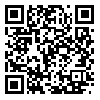Volume 7, Issue 1 (Winter 2018)
Arch Hyg Sci 2018, 7(1): 23-31 |
Back to browse issues page
Download citation:
BibTeX | RIS | EndNote | Medlars | ProCite | Reference Manager | RefWorks
Send citation to:



BibTeX | RIS | EndNote | Medlars | ProCite | Reference Manager | RefWorks
Send citation to:
Khandan M, Momenyan S, Khodabandeloo M, Koohpaei A. Relationship between Job Stress and Ergonomic Behavior with Musculoskeletal Disorders in an Auto-part Production Company. Arch Hyg Sci 2018; 7 (1) :23-31
URL: http://jhygiene.muq.ac.ir/article-1-259-en.html
URL: http://jhygiene.muq.ac.ir/article-1-259-en.html
1- Qom University of Medical Sciences
2- Shahid Beheshti University of Medical Sciences
3- Occupational Health Department, Health School, Work Health Research Centre, Qom University of Medical Sciences, Qom, Iran
2- Shahid Beheshti University of Medical Sciences
3- Occupational Health Department, Health School, Work Health Research Centre, Qom University of Medical Sciences, Qom, Iran
Abstract: (4427 Views)
| Background & Aims of the Study: Worker’s behaviors, uncontrolled job stress, psycho- social factors and non-ergonomic principles, lead to risk of musculoskeletal disorders. This rsearch was done conducted to analyze relationship these factors in an auto-parts production company in Qom province, Iran in 2015. Materials and Methods: This study was a cross-sectional one conducted on all workers (n=113). To measure the ergonomic behavior, behavioral sampling checklist was used. Researcher-made demographic and Nordic questionnaire beside valid HSE job stress questionnaire were used. Data analysis was done with SPSS V20 using Poisson regression method. Results:: Age’s average of studied workers was 26.76±4.6 and work history was 3.49±3.36 years. Eighty nine ones (%66.9) experienced at least musculoskeletal pain at one part of their body. Highest rate of pain was reported in low back pain (58.42%). Among 1792 observed behavior, 49.61% of behaviors were ergonomic. The manual handling behavior with 76.19% as the rate was the worst. Mean (±SD) of occupational stress score was measured 95.72 (±14.25). According to Poisson regression musculoskeletal disorders among men were significantly less than women (38.3%) (P=0.04). With one unit, increasing in ergonomic behavior, disorders were decreased 3.35 times (P <0.001). Also, accompanied with increasing the demand score, we would be experienced a 50% reduction in musculoskeletal disorders. |
Type of Study: Original Article |
Subject:
Occuptional Health
Received: 2017/08/13 | Accepted: 2017/12/20 | Published: 2018/01/1
Received: 2017/08/13 | Accepted: 2017/12/20 | Published: 2018/01/1
Send email to the article author
| Rights and permissions | |
 |
This work is licensed under a Creative Commons Attribution-NonCommercial 4.0 International License. |








